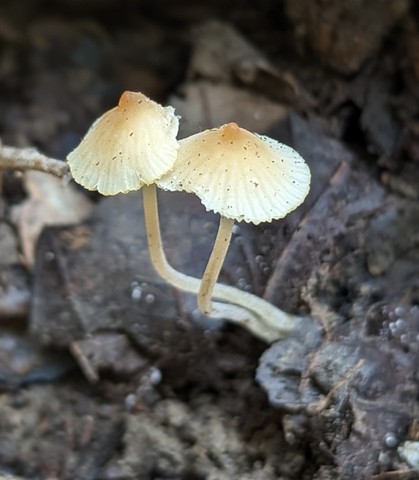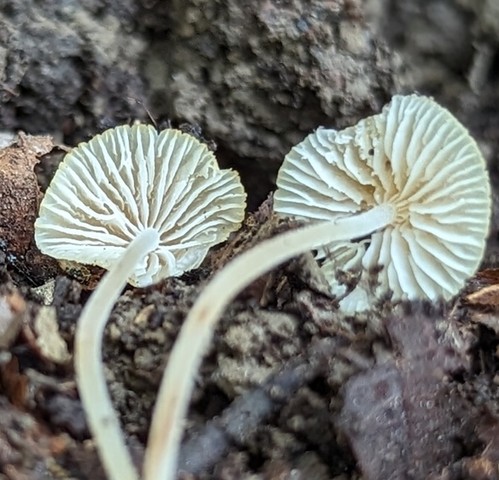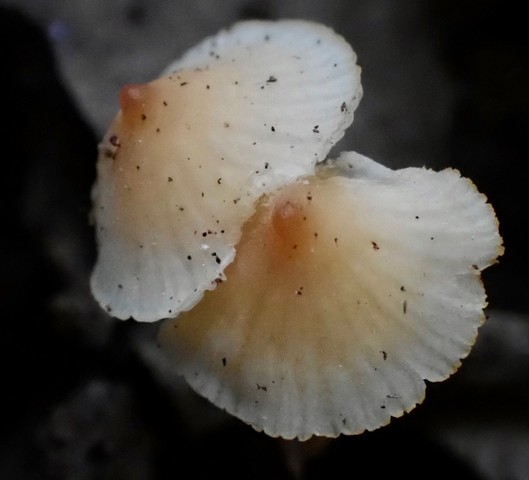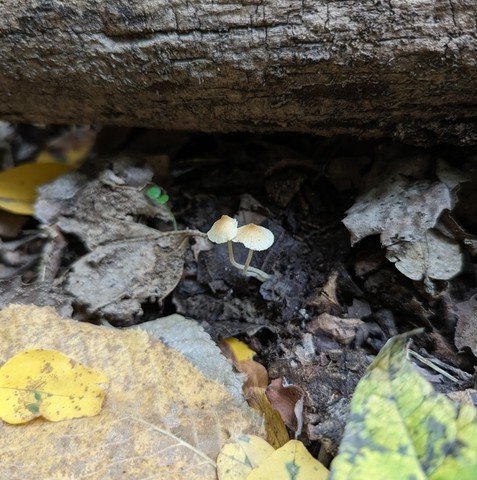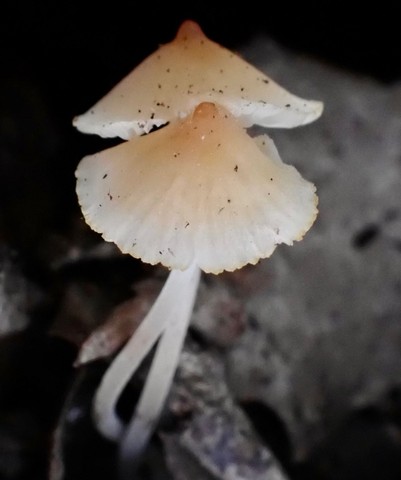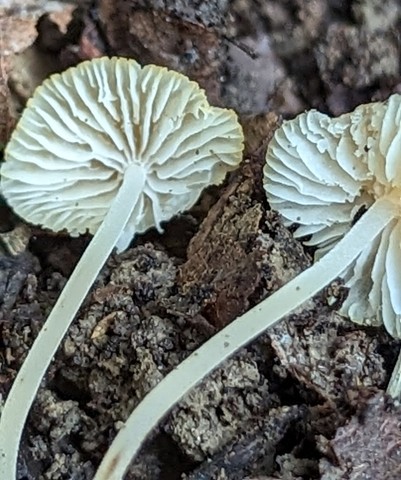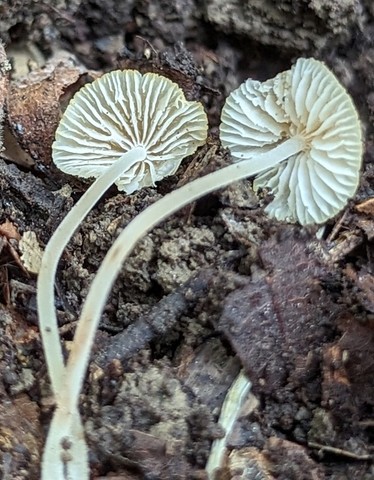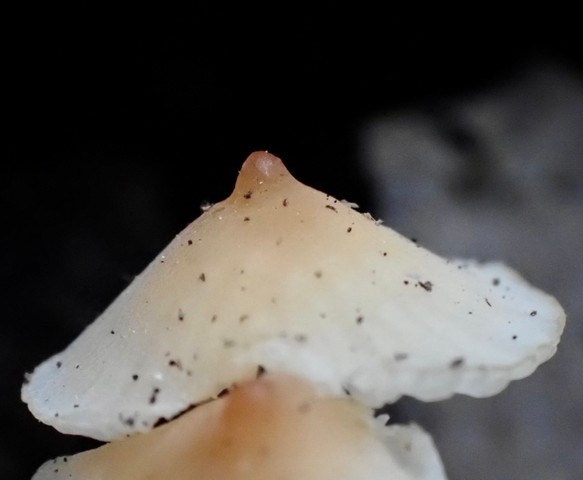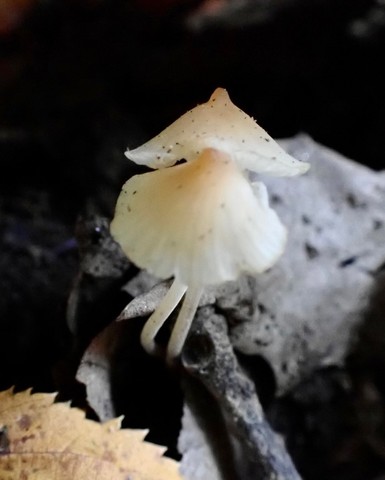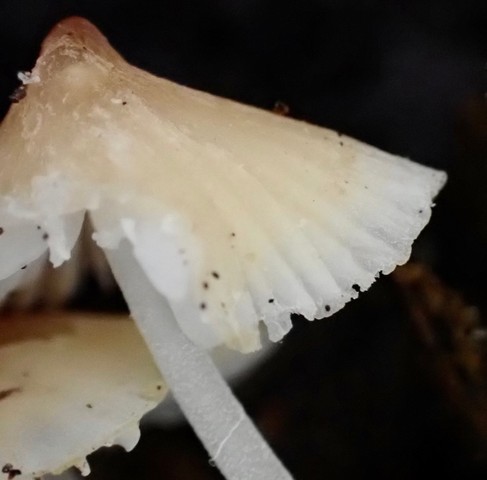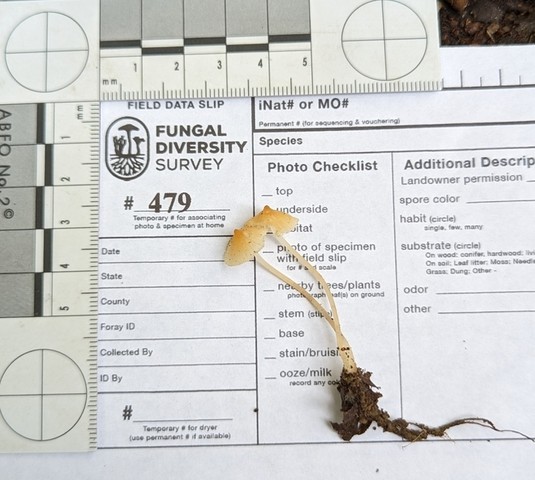Eastern Tangerine Athena
Atheniella leptophylla
Life > Fungi > Basidiomycota > Agaricomycotina > Agaricomycetes > Agaricomycetidae > Agaricales > Marasmiineae > Marasmiaceae > Atheniella
Description
The Eastern Tangerine Athena (Atheniella leptophylla) is a decomposer of duff and wood, and can be found in September in woodland areas. It is small, grows alone or in small groups, and has a Mycenoid stature, sharing features with the genus Mycena.
Cap: convex or bell-shaped, and sometimes papillate (with a nipple-shaped umbo). The surface is smooth and presents a striped pattern when moist from the gills underneath (translucent-striate). It is pale reddish-yellow, brighter toward the center (disc), and becomes pleated at the margin with age.
Gills: close, narrow, and attached to the stem with a decurrent tooth (uncinate), yellowish to whitish in color.
Stem: slender, hollow, smooth at the apex and center with coarse fibrils towards the base.
Spore Print: white.
Etymology: leptophylla comes from the Greek roots lepto- meaning "slender" and -phylla meaning "leaf" or "gill," referring to its thin gills.
Observations
October 23rd, 2023 Indian Cave State Park
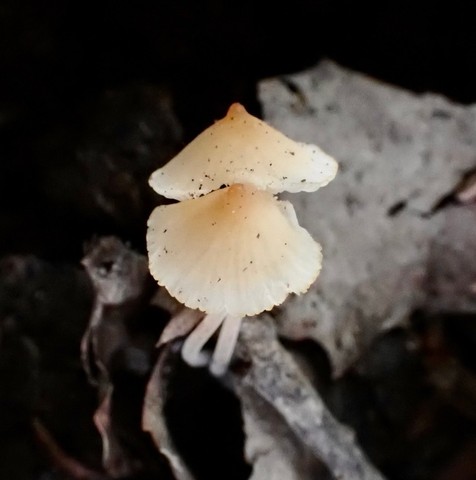
479
Observed At: Tuesday, October 24, 2023 2:27 PM Created At: Tuesday, October 24, 2023 2:27 PM Last Modified At: Tuesday, October 24, 2023 2:34 PM Location: 40.26438530470901 -95.55880977653159 Form Group: Form Group: agaric Substrate: Substrate: terrestrial, humicolous Growth Habit: Growth Habit: caespitose Habitat: Same as prior Cap: Pileus: ( Shape: ( Profile: umbo to mammillate; papillate ); Surface: ( color: cream to buff-yellow to yellowish brown [1] ); Margin: ( Features: striate; plicate ) ) Shape: Shape: ( Profile: umbo to mammillate; papillate ) Surface: Surface: ( color: cream to buff-yellow to yellowish brown [2] ) Margin: Margin: ( Features: striate; plicate ) Gills: Lamellae: ( Attachment: uncinate ) Stem: Stipe: ( shape: terete to equal ) Footnotes: [1] Cap from center to margin: yellowish brown, buff yellow, to cream. [2] Cap from center to margin: yellowish brown, buff yellow, to cream.
GTCGTAACAAGGTTTCCGTAGGTGAACCTGCGGAAGGATCATTACTGAATTTCTGGAGTGTTGTCGCTGGCTTTTCGGAGCATGTGCACGCACTTCAAATTCTTCTCAACCACCTGTGCACTTTTGTAGACTATGATAACTCTCAATGATTTTATTATCTATTGGATTGAAGGACTTGCGTTTCAGCTGGTCTCTTCAACTTCATAGTCTACGTCTTATCTATAAACAAAGTCTTAGAATGTCTTTAATGGGTCTTTTTGACCTATAAAAACTAATACAACTTTCAACAACGGATCTCTTGGCTCTCGCATCGATGAAGAACGCAGCGAAATGCGATAAGTAATGTGAATTGCAGAATTCAGTGAATCATCGAATCTTTGAACGCACCTTGCACTCCTTGGTATTCCGAGGAGTATGCCTGTTTGAGTGTCATTAAATTCTCAAACCTTATTGACTTTATTGACAATGAGGCTTTGGATGTGGGAGTTTGCCGGCTTCTAACGAAGTCAGCTCTCCTTAAATACATTAGTGGTTACTGTTCCCCACTATATGGTGTGATAATTATCTACGCCTTGGTGGGGTTGTTAAGTGTAGCTGCTCTCTAACTGTCTCTCTTTCGAGACAACTTTGAACCATTTGACCTCAAATCAGGTAGGACTACCCGCTGAACTTView MycoMap DNA Results
References
Gminder, A. 2016. Nomenclatural novelties. Index Fungorum. 302:1-1 http://www.indexfungorum.org/Publications/Index%20Fungorum%20no.302.pdf
Kalichman, J. (2023). Names - Agaricus & Agaricales. Retrieved October 14, 2025, from Agaric.us website: https://agaric.us/common_names/names.html
Kalichman, J. (2023). Names - Agaricus & Agaricales. Retrieved October 14, 2025, from Agaric.us website: https://agaric.us/common_names/names.html
Peck, C.H. 1872. Report of the Botanist (1870). Annual Report on the New York State Museum of Natural History. 24:41-108 https://www.mykoweb.com/systematics/literature/Report%20of%20the%20State%20Botanist%201870.pdf
Redhead, SA. 2012. Nomenclatural novelties. Index Fungorum. 14:1-1 http://www.indexfungorum.org/Publications/Index%20Fungorum%20no.14.pdf
Created December 15, 2025 at 10:41 AM
